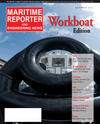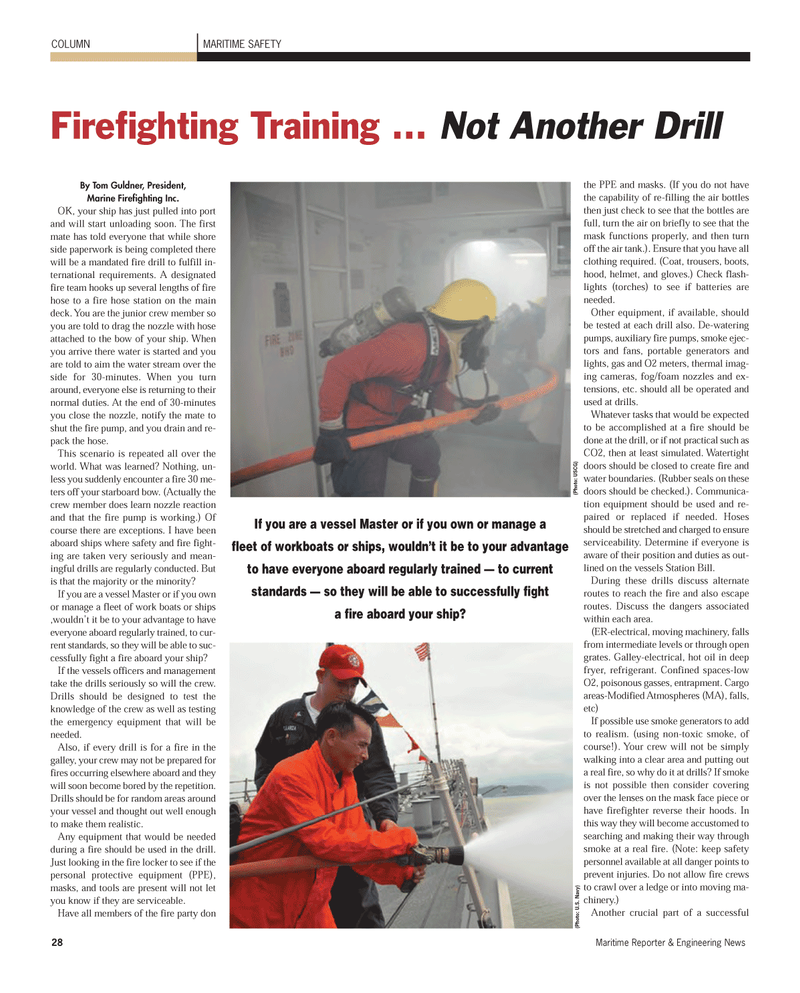
Page 28: of Maritime Reporter Magazine (November 2011)
Feature: Workboat Annual
Read this page in Pdf, Flash or Html5 edition of November 2011 Maritime Reporter Magazine
28Maritime Reporter & Engineering News By Tom Guldner, President, Marine Firefighting Inc.OK, your ship has just pulled into portand will start unloading soon. The first mate has told everyone that while shore side paperwork is being completed there will be a mandated fire drill to fulfill in- ternational requirements. A designated fire team hooks up several lengths of fire hose to a fire hose station on the main deck. You are the junior crew member so you are told to drag the nozzle with hoseattached to the bow of your ship. When you arrive there water is started and you are told to aim the water stream over the side for 30-minutes. When you turn around, everyone else is returning to their normal duties. At the end of 30-minutes you close the nozzle, notify the mate toshut the fire pump, and you drain and re- pack the hose. This scenario is repeated all over the world. What was learned? Nothing, un- less you suddenly encounter a fire 30 me- ters off your starboard bow. (Actually the crew member does learn nozzle reaction and that the fire pump is working.) Of course there are exceptions. I have been aboard ships where safety and fire fight- ing are taken very seriously and mean- ingful drills are regularly conducted. But is that the majority or the minority?If you are a vessel Master or if you own or manage a fleet of work boats or ships ,wouldn?t it be to your advantage to have everyone aboard regularly trained, to cur- rent standards, so they will be able to suc- cessfully fight a fire aboard your ship? If the vessels officers and management take the drills seriously so will the crew. Drills should be designed to test theknowledge of the crew as well as testing the emergency equipment that will be needed.Also, if every drill is for a fire in the galley, your crew may not be prepared for fires occurring elsewhere aboard and they will soon become bored by the repetition.Drills should be for random areas aroundyour vessel and thought out well enough to make them realistic. Any equipment that would be needed during a fire should be used in the drill. Just looking in the fire locker to see if the personal protective equipment (PPE), masks, and tools are present will not letyou know if they are serviceable. Have all members of the fire party don the PPE and masks. (If you do not have the capability of re-filling the air bottles then just check to see that the bottles arefull, turn the air on briefly to see that themask functions properly, and then turn off the air tank.). Ensure that you have all clothing required. (Coat, trousers, boots,hood, helmet, and gloves.) Check flash- lights (torches) to see if batteries areneeded.Other equipment, if available, should be tested at each drill also. De-watering pumps, auxiliary fire pumps, smoke ejec- tors and fans, portable generators and lights, gas and O2 meters, thermal imag- ing cameras, fog/foam nozzles and ex- tensions, etc. should all be operated andused at drills. Whatever tasks that would be expected to be accomplished at a fire should be done at the drill, or if not practical such asCO2, then at least simulated. Watertight doors should be closed to create fire and water boundaries. (Rubber seals on these doors should be checked.). Communica- tion equipment should be used and re-paired or replaced if needed. Hosesshould be stretched and charged to ensure serviceability. Determine if everyone is aware of their position and duties as out- lined on the vessels Station Bill. During these drills discuss alternateroutes to reach the fire and also escape routes. Discuss the dangers associatedwithin each area. (ER-electrical, moving machinery, falls from intermediate levels or through open grates. Galley-electrical, hot oil in deep fryer, refrigerant. Confined spaces-low O2, poisonous gasses, entrapment. Cargo areas-Modified Atmospheres (MA), falls, etc)If possible use smoke generators to add to realism. (using non-toxic smoke, of course!). Your crew will not be simply walking into a clear area and putting out a real fire, so why do it at drills? If smoke is not possible then consider covering over the lenses on the mask face piece or have firefighter reverse their hoods. In this way they will become accustomed to searching and making their way through smoke at a real fire. (Note: keep safety personnel available at all danger points to prevent injuries. Do not allow fire crews to crawl over a ledge or into moving ma- chinery.) Another crucial part of a successfulMARITIME SAFETYCOLUMNFirefighting Training ... Not Another Drill(Photo: U.S. Navy)If you are a vessel Master or if you own or manage a fleet of workboats or ships, wouldn?t it be to your advantage to have everyone aboard regularly trained ? to current standards ? so they will be able to successfully fight a fire aboard your ship? (Photo: USCG)MR Nov.11 # 4 (25-33):MR Template 10/27/2011 9:18 AM Page 28

 27
27

 29
29
